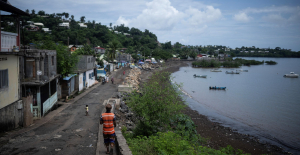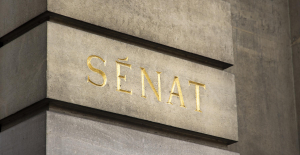Didier Leroy is a researcher at the Royal Military School of Belgium and the Free University of Brussels (ULB). He defended a doctoral thesis on the ideological and structural evolution of Lebanese Hezbollah.
LE FIGARO.- Hamas launched a raid from Gaza on Saturday October 7, which led to the death of more than 900 Israelis. Its ally Hezbollah has remained eerily calm, apart from a few rockets towards the Golan Heights. Why such restraint?
DIDIER LEROY. - Lebanese Hezbollah did not fail to congratulate this member of the “axis of resistance” for this audacious operation, which is in line with the agenda shared by all the militias supported by the Islamic Revolutionary Guards in Iran. Hezbollah fired a few rockets at IDF military positions (the Israeli army, editor's note), the Chebaa farms, in a sulphurous zone separating southern Lebanon and Israel. But shootings are common in the region, so no red lines have been crossed.
On the other hand, what raised tensions a notch was the attempted infiltration of several individuals from Lebanon. They were recognized as belonging to Islamic Jihad (a Palestinian militia based in Gaza and Lebanon, Editor’s note) which partly clears Hezbollah. In any case, no Palestinian action can be undertaken in the blue line (the Lebanese-Israeli border, Editor's note) without the tacit approval of Hezbollah. Israel carefully examines this border to prevent potential future incursions. We are in a sort of in-between where the tension increases, but slowly.
In my opinion, the Hezbollah command is carefully monitoring the civil disobedience cursor in the West Bank, and in the mixed (Jewish and Arab, Editor's note) cities of Israel. Hamas called for a general mobilization, that is to say a new intifada, with the hope of weakening the Israeli security apparatus by multiplying the fronts. Clearly, it is the evolution of internal fronts that external actors, such as Hezbollah, are monitoring and which could change their assessment and their possible entry on the scene.
Also read: Israel: why a ground operation in the Gaza Strip promises to be particularly complex
The only thing that encourages Hezbollah to restrain is Lebanon's economic situation. The country has been bloodless since 2019 and hopes for the return of Gulf funds after the détente between Saudi Arabia and Iran under the auspices of China. In addition, the exploitation of offshore gas fields has just begun. If Hezbollah were to provoke Israel, and ultimately bring about the destruction of part of the country, at a time when Lebanon has economic hope, it would be very badly received. The country is very divided on the Palestinian question, even divided in two. Hezbollah would then have to do battle with the IDF and half of the Lebanese population.
Can we estimate Hezbollah’s arsenal?
Hezbollah is an ally of Iran, which explains why part of its arsenal is of Iranian manufacture, and the other of local manufacture. Hassan Nasrallah, the secretary general of Hezbollah, announced that its armed wing now has 100,000 fighters. This figure is undoubtedly exaggerated; most analysts cite 25,000 full-time soldiers, around whom reservists gravitate. Its arsenal also includes 130,000 projectiles, rockets and missiles, as well as tanks, drones, launchers, etc. Hezbollah is the most formidable militia actor in the entire Middle East.
If an insurgency broke out in the West Bank and Hezbollah attacked from Lebanon, could the IDF cope?
The Israeli military hopes to avoid this scenario at all costs! It still has, let us not forget, a certain technological superiority. It still has F-35s, fifth generation aircraft, but also a very efficient and tripartite anti-aircraft defense system: the iron dome, for unsophisticated rockets, the David sling system for medium-range missiles and the boom system for long-range missiles. For several years, the Israeli army has also been promoting laser technology suitable for anti-aircraft defense. Which could be an asset, because each Iron Dome missile costs several tens of thousands of dollars, while the laser costs five dollars.
Israel's main weakness is the restlessness of its own society. In some mixed regions, we will see greater polarization between Jewish and Arab individuals. But within Jewish society itself, we have still witnessed unprecedented demonstrations with justice reform. Israel is therefore a strong military actor, but feverish and weakened. Its main danger is to see the bond between citizens eroded.

 Germany: a new research operation will be launched for a 6-year-old autistic child
Germany: a new research operation will be launched for a 6-year-old autistic child Gaza: under the spotlight, the Israeli-Palestinian conflict shakes up the Eurovision contest
Gaza: under the spotlight, the Israeli-Palestinian conflict shakes up the Eurovision contest Black soldier killed by a police officer in the United States: the sheriff publishes the video of the arrest
Black soldier killed by a police officer in the United States: the sheriff publishes the video of the arrest In Malmö, the Eurovision party transformed into entrenched camps
In Malmö, the Eurovision party transformed into entrenched camps “Mediterranean diet” or “DASH”, two good tips for eating better
“Mediterranean diet” or “DASH”, two good tips for eating better Fatal case of cholera in Mayotte: the epidemic is “contained”, assures the government
Fatal case of cholera in Mayotte: the epidemic is “contained”, assures the government The presence of blood in the urine, a warning sign of bladder cancer
The presence of blood in the urine, a warning sign of bladder cancer A baby whose mother smoked during pregnancy will age more quickly
A baby whose mother smoked during pregnancy will age more quickly Climbing the steps, stars, evenings… “Gala” is available daily during the Cannes Film Festival
Climbing the steps, stars, evenings… “Gala” is available daily during the Cannes Film Festival The closure of MA France marks the end of the automobile industry in Seine-Saint-Denis
The closure of MA France marks the end of the automobile industry in Seine-Saint-Denis Satellifacts, daily newspaper specializing in audiovisual, acquired by the financial news media CFNews
Satellifacts, daily newspaper specializing in audiovisual, acquired by the financial news media CFNews First stop to Chinese solar panels
First stop to Chinese solar panels Léa Seydoux at the heart of a new project by Leos Carax
Léa Seydoux at the heart of a new project by Leos Carax The general director of the Picasso Museum soon to head the Lyon Biennale
The general director of the Picasso Museum soon to head the Lyon Biennale Sylvie Pialat replaces Sorogoyen at the head of Critics’ Week
Sylvie Pialat replaces Sorogoyen at the head of Critics’ Week Jazz: death of famous guitarist Christian Escoudé
Jazz: death of famous guitarist Christian Escoudé Omoda 7, another Chinese car that could be manufactured in Spain
Omoda 7, another Chinese car that could be manufactured in Spain BYD chooses CA Auto Bank as financial partner in Spain
BYD chooses CA Auto Bank as financial partner in Spain Tesla and Baidu sign key agreement to boost development of autonomous driving
Tesla and Baidu sign key agreement to boost development of autonomous driving Skoda Kodiaq 2024: a 'beast' plug-in hybrid SUV
Skoda Kodiaq 2024: a 'beast' plug-in hybrid SUV The home mortgage firm rises 3.8% in February and the average interest moderates to 3.33%
The home mortgage firm rises 3.8% in February and the average interest moderates to 3.33% This is how housing prices have changed in Spain in the last decade
This is how housing prices have changed in Spain in the last decade The home mortgage firm drops 10% in January and interest soars to 3.46%
The home mortgage firm drops 10% in January and interest soars to 3.46% The jewel of the Rocío de Nagüeles urbanization: a dream villa in Marbella
The jewel of the Rocío de Nagüeles urbanization: a dream villa in Marbella LFI: Manon Aubry places social issues at the center of her European campaign
LFI: Manon Aubry places social issues at the center of her European campaign Diving into the secrets of the National Assembly
Diving into the secrets of the National Assembly Institutions: senators want to restore the accumulation of mandates and put an end to the automatic presence of ex-presidents on the Constitutional Council
Institutions: senators want to restore the accumulation of mandates and put an end to the automatic presence of ex-presidents on the Constitutional Council Europeans: David Lisnard expresses his “essential and vital” support for François-Xavier Bellamy
Europeans: David Lisnard expresses his “essential and vital” support for François-Xavier Bellamy These French cities that will boycott the World Cup in Qatar
These French cities that will boycott the World Cup in Qatar UNFP Trophies: Éric Roy (Brest) voted best coach of the season in Ligue 1
UNFP Trophies: Éric Roy (Brest) voted best coach of the season in Ligue 1 “The love I have for PSG is sincere”: Kurzawa announces his departure from the club
“The love I have for PSG is sincere”: Kurzawa announces his departure from the club Ligue 1: Marquinhos, Mbappé, Aubameyang... The typical team of the season
Ligue 1: Marquinhos, Mbappé, Aubameyang... The typical team of the season UNFP Trophies: Kylian Mbappé wins a fifth consecutive title as best player of the season
UNFP Trophies: Kylian Mbappé wins a fifth consecutive title as best player of the season


















